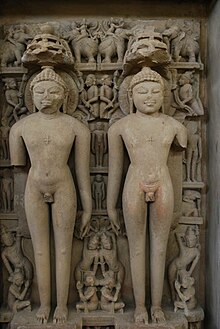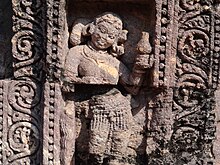Nudity in India
Nudity in India has a multifaceted history, deeply rooted in the nation's religious, cultural, and social practices. While public nudity is generally frowned upon in modern urban areas, specific religious and traditional contexts have embraced forms of nudity as symbols of purity, renunciation, or spirituality. It is worth noting that the depiction of nudity in Indian art doesn't support the claim that public nudity was acceptable/normal across all castes and regions in India. By contemporary standards, the unclothed female upper body is considered semi-nude or a sign of obscene nudity, however, historically some regions and classes/castes of modern-day India, have traditionally had this kind of public nudity/semi-nudity as the norm.[1][2]

History
[edit]The history of nudity in India is a tapestry of evolving cultural, religious, and social norms. Spanning over millennia, the perception and representation of nudity have undergone significant transformations, reflecting the broader shifts in Indian society.
Ancient Period
[edit]Indus Valley Civilization (3300–1300 BCE): The artifacts from this period, particularly the terracotta figurines, display both male and female forms, sometimes in semi-nude states.[3] These depictions highlight the civilization's possible comfort with the human form and its aesthetic appreciation. The Dancing Girl is a notable bronze statue from Mohenjo-Daro, one of the major sites of the Indus Valley Civilization. This figurine depicts a young woman in a semi-nude state and is currently housed at the National Museum in New Delhi.[4]
Vedic Period (1500–500 BCE): The Rigveda, one of the oldest Indian scriptures, makes occasional references to nudity, especially in the context of ascetic practices.[5][6] Nudity was seen as a form of renunciation from worldly attachments.[7]
Classical Period
[edit]Buddhism and Jainism (6th Century BCE onwards): Ascetic practices in both religions sometimes involved renouncing clothing. Particularly in Jainism, the Digambara sect (meaning "sky-clad") had monks who embraced nudity as a symbol of complete detachment.[8]
Temple Art and Sculpture: The temples from the Gupta and post-Gupta periods, like Khajuraho, display intricate carvings of both divine and human figures in the erotic or non-erotic nude poses.[9] These weren't viewed as profane but rather as symbolic representations of divine beauty, the cycle of life, and the interplay of the cosmic principles.[9] Similar works have been found with reference to the Chola empire.[10]
Medieval Period
[edit]Yogi practices: Yogis have historically worn minimal clothing, and many were nude. This practice aligns with their belief in the importance of asceticism, the distancing from the material desires and attachments. In the biography of Saint Gorakhnath for example, we have references to nude male and female yogis who had visited the famous Amarnath Temple during medieval period of India.[11]

Islamic Invasion (12th Century onwards): With the advent of Islamic rulers, there was a cultural shift. The new rulers brought with them more conservative views on nudity and representation of the human form, leading to a decline in the artistic representation of nudity in public spaces, as well as a decline in public nudity in general.[12]
Bhakti and Sufi Movements: While the larger society became more conservative, the Bhakti and Sufi poets often used the metaphor of nakedness to symbolize purity, innocence, and a soul stripped of worldly desires.[13] In Odisha, the Konark Sun Temple has nude artworks from the 13th century CE.[14] The Kashmiri saint Lalleswari is said to have discarded her clothes and danced naked.[15]

Modern/Colonial Era
[edit]British Colonial Rule (19th and 20th Centuries): Victorian morals and the British legal system further entrenched conservative views on nudity. The Indian Penal Code, introduced in 1860, criminalized public nudity. There was also a noticeable shift in the Indian art scene, with fewer depictions of the nude form as artists catered to the tastes of their colonial patrons.[1][16]
In 19th century Travancore, baring of one's chest to higher status people was considered a sign of respect by both males and females. Thus, those of the lower status castes, such as the Nadar climbers, Even women of other dominant castes like the Nairs had to keep their breasts bare in the presence of Brahmin men. Nair women had no right to hide their breasts in front of them.[17] The Channar revolt was the Nadar climber women's fight for more than four decades, for the right to wear upper-body garments.
Post-Independence Era
[edit]After gaining independence in 1947, India saw a resurgence in interest in its classical arts, leading to a more liberal view of nudity in artistic contexts.[18] However, in the broader public sphere, nudity remained a taboo, influenced by centuries of changing norms and external influences. This has resulted in protests and attacks against modernist artists such as M. F. Hussain.[19]
-
Group of Indian native children in the 1890s. Nudity among children is considered natural in most of India.
-
Semi nude women with a king on the horse in the background- Deccani Painting , 19th century
-
Rodiya woman carrying water, Ceylon 1910
-
Lady After A Bath, Mughal Art, 18th century
References
[edit]- ^ a b Sheth, Falguni A. (2022). Unruly Women: Race, Neocolonialism, and the Hijab. Oxford University Press. ISBN 978-0-19-754713-7.
- ^ Crooke, W. (1919). "Nudity in India in Custom and Ritual". The Journal of the Royal Anthropological Institute of Great Britain and Ireland. 49: 237–251. doi:10.2307/2843441. ISSN 0307-3114. JSTOR 2843441.
- ^ McIntosh, Jane (2008). The Ancient Indus Valley: New Perspectives. Bloomsbury Academic. pp. 281, 407. ISBN 978-1-57607-907-2.
- ^ Singh, Upinder (2008). A History of Ancient and Early Medieval India: From the Stone Age to the 12th Century. Pearson Education India. p. 162. ISBN 978-81-317-1120-0.
- ^ Sanyal, Jagdiswar (1999). Guide to Indian Philosophy. Kolkata.
{{cite book}}: CS1 maint: location missing publisher (link) - ^ Hopkins, Edward Washburn (1893). "Problematic Passages in the Rig-Veda". Journal of the American Oriental Society. 15: 252–283. doi:10.2307/592358. ISSN 0003-0279. JSTOR 592358.
- ^ Vedantaprana, Pravrajika. Saptahik Bartaman. Kolkata: 2015. pp. Vol. 28, no. 23.
- ^ Dundas, Paul (2002). The Jains. Library of religious beliefs and practices (2nd ed.). London New York: Routledge. p. 2. ISBN 978-0-415-26605-5.
- ^ a b Daniélou, Alain (2001). The Hindu Temple: Deification of Eroticism. Inner Traditions / Bear & Co. pp. 3, 11. ISBN 978-0-89281-854-9.
- ^ Dehejia, Vidya (2006). Chola: Sacred Bronzes of Southern India. Royal Academy of Arts. pp. 29, 37, 153. ISBN 978-1-903973-84-4.
- ^ Sankarnath, Roy (1980). Bharater Sadhak [Saints of India]. Hare Street, Kolkata. pp. Vol. 7.
{{cite book}}: CS1 maint: location missing publisher (link) - ^ Seshan, Radhika; Kulkarni, Anant R., eds. (2006). Medieval India: problems and possibilities: essays in honour of Professor A. R. Kulkarni. Jaipur: Rawat Publications. ISBN 978-81-316-0015-3.
- ^ Thaosen, Maduli (2017-04-02). "The Bhakti Movement and Roots of Indian Feminism". Feminism in India. Retrieved 2023-11-01.
- ^ Coomaraswamy, Ananda Kentish (1985). History of Indian and Indonesian Art. Dover Publications. ISBN 978-0-486-25005-2.
- ^ Ramaswamy, Vijaya (1992). "Rebels — Conformists? Women Saints in Medieval South India". Anthropos. 87 (1/3): 133–146. ISSN 0257-9774. JSTOR 40462578.
- ^ Sharma, Vishnu D.; Wooldridge, F. (1973). "The Law Relating to Obscene Publications in India". The International and Comparative Law Quarterly. 22 (4): 632–647. doi:10.1093/iclqaj/22.4.632. ISSN 0020-5893. JSTOR 757659.
- ^ Valsiner, Jaan (2020-06-23). Sensuality in Human Living: The Cultural Psychology of Affect. Springer Nature. ISBN 978-3-030-41743-7.
- ^ Boehmer, Elleke; Chaudhuri, Rosinka (2010-10-04). "see Chapter:2". The Indian Postcolonial: A Critical Reader. Routledge. ISBN 978-1-136-81956-8.
- ^ Grimes, William (2011-06-09). "Maqbool Fida Husain, India's Most Famous Painter, Dies at 95". The New York Times. ISSN 0362-4331. Retrieved 2023-11-02.



